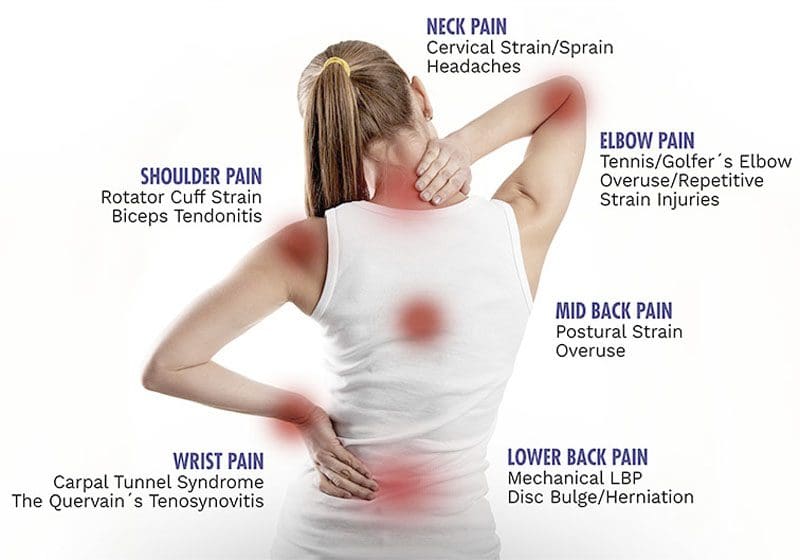
Table of Contents
Length of time for tendonitis to heal
Healing time depends on the overall health, age, and how serious the tendonitis is.- A mild case for a person under 40 could heal in two to four weeks
- A moderate case in 4 to 6 weeks
- An extreme case can take months
Symptoms and Signs
Mild cases can feel like sore muscles. However, moderate symptoms, depending on the affected area, can include:Shoulder
When reaching for something or lifting an object, pain is felt in the shoulder.Elbow
Pain sometimes can be sharp on the outside of the elbow joint. This along with sore muscles or muscles that are painful to the touch. In the forearm and wrist, it can happen in the inner elbow but is not as common.Wrist
Pain is usually in the inner joint of the wrist or below the thumb. And the joint is tender/sensitive to the touch. It can make driving a painful task.
In the Knee
Swelling and stiffness are common, along with pain when bending, walking, or when putting weight on the affected knee.In the Foot
Pain is felt in the Achilles and the foot is tender/sensitive when walking.If left untreated will it go away on its own?
In certain cases. it can but one should never ignore pain symptoms. Pain is the body’s way of telling the individual that there is something wrong.Resting the affected tendons
The first thing a doctor will say is that the painful area needs to rest from various types of activities. Rest works to alleviate the symptoms of only the mildest forms of tendonitis. Most individuals are unaware that they have tendonitis until it reaches the moderate stage. Resting the affected area does help, however, even with moderate damage, rest alone probably won’t take care of the inflammation. An individual will need to do some sort of stretching/strengthening/rehabilitation of the area. Otherwise, when returning to normal activities including what caused the injury the individual is only going to overuse the tendon/s again.Difficult to completely rest the affected joint/s
Completely resting the arm, hand, shoulder, or foot for 4-6 weeks is a serious challenge. Most individuals will not be able to accomplish this with their job, children, and all the other responsibilities that they have for 4-6 weeks. Most individuals can take a week, but even then don’t really stop using the affected joint completely. When the regular routine returns along with the activity/job that caused the tendonitis, because of the light rest, the pain comes back within a few days to a few weeks.It can become a chronic condition left untreated
When left untreated tendonitis can become chronic. What happens is the constant inflammation progressively becomes chronic. Healing chronic tendonitis is a long and painful process that can require surgery. A chronic case can take months to heal along with rehabilitation to strengthen the affected tendons. Chronic cases can feel like a knife being driven into the joint, even with simple tasks like turning/pulling a door handle.
Avoiding surgery
Continued use of the joint means inflammation will continue and it will get worse. In severe cases, where conservative treatment/s has not helped surgery could be required. When it comes to tendon surgery, it does not heal like a broken bone. After the surgery, the joint can become permanently stiff and the full range of motion does not return. Healing time is around 12 weeks, depending on the overall health, age, and severity. A full recovery could take as long as 6 months. Avoiding surgery can be accomplished if proper treatment is sought out as soon as there is a feeling of joint tingling, numbness, and pain.Healing treatment
Getting treatment as soon as possible is key. Even if the pain is not tendonitis but a pulled muscle, the body will heal faster with the proper treatment. Chiropractors are highly skilled specialists in the musculoskeletal system. Chiropractic care that includes manipulation, massage, ultrasound, etc. has shown to be highly effective in the treatment of tendonitis. Depending on the diagnosis, a chiropractor will utilize other therapies as a part of the treatment plan, including:- Therapeutic massage
- Heat therapy
- Rehabilitation exercise
- Rehabilitation stretching
- Cold laser therapy
- Ergonomic changes to the workstation
- Taking anti-inflammatory supplements
- Refer the individual to a different specialist if other issues fall outside of their range of practice.
Tendonitis left untreated
Untreated tendonitis can lead to the permanent weakening of the tendon. This can lead to a rupture of the tendon, which requires surgery. It can also cause permanent damage to the tissues surrounding the area, as well as, scar tissue can form in and around the area. The pain and inflammation continue because the scar tissue is not as flexible as tendons. This often causes individuals to force the affected joint to work harder causing added inflammation. Untreated tendonitis can turn into a life-long issue that interferes with everyday activities like getting dressed, walking, eating, etc. Get started with a proper treatment and recovery plan to get back to living a healthy, pain-free life.Body Composition
Tracking inflammation/fluid imbalances from injury or surgery
After surgery or injury, inflammation can present with little or no visible symptoms. Precise measures of the body’s water can detect water retention and inflammation. This could help guide rehabilitation treatment. InBody effectively distinguishes water in the intracellular/within the tissues and extracellular/in the blood/interstitial fluids water that comprises total body water. The Edema Index can be used to detect fluid imbalances resulting from inflammation brought on by injury or surgery recovery. By assessing fluid balance in the body, inflammation can be identified, used to guide treatment options, and reduce the risk of re-injury or post-surgery complications. Tracking these values back to normal will help therapists by providing proof of the success of the treatment plan.Dr. Alex Jimenez’s Blog Post Disclaimer
The scope of our information is limited to chiropractic, musculoskeletal, physical medicines, wellness, and sensitive health issues and/or functional medicine articles, topics, and discussions. We use functional health & wellness protocols to treat and support care for injuries or disorders of the musculoskeletal system. Our posts, topics, subjects, and insights cover clinical matters, issues, and topics that relate and support directly or indirectly our clinical scope of practice.* Our office has made a reasonable attempt to provide supportive citations and has identified the relevant research study or studies supporting our posts. We also make copies of supporting research studies available to the board and or the public upon request. We understand that we cover matters that require an additional explanation as to how it may assist in a particular care plan or treatment protocol; therefore, to further discuss the subject matter above, please feel free to ask Dr. Alex Jimenez or contact us at 915-850-0900. The provider(s) Licensed in Texas& New Mexico*References
Sharma P, Maffulli N. Biology of tendon injury: healing, modeling, and remodeling. J Musculoskelet Neuronal Interact. 2006;6(2):181-90. Dean BJF, et al., Review: Emerging concepts in the pathogenesis of tendinopathy, The Surgeon (2017), http://dx.doi.org/10.1016/j.surge.2017.05.005 Wilson JJ, Best TM. Common overuse tendon problems: a review and recommendations for treatment. Am Fam Phys. Sep 1 2005;72(5):811e8.Post Disclaimer
Professional Scope of Practice *
The information herein on "Why Tendonitis Should Not Be Left Untreated A Chiropractic Perspective" is not intended to replace a one-on-one relationship with a qualified health care professional or licensed physician and is not medical advice. We encourage you to make healthcare decisions based on your research and partnership with a qualified healthcare professional.
Blog Information & Scope Discussions
Welcome to El Paso's Chiropractic Scientist wellness blog, where Dr. Alex Jimenez, DC, FNP-C, a board-certified Family Practice Nurse Practitioner (FNP-C) and Chiropractor (DC), presents insights on how our team is dedicated to holistic healing and personalized care. Our practice aligns with evidence-based treatment protocols inspired by integrative medicine principles, similar to those found on dralexjimenez.com, focusing on restoring health naturally for patients of all ages.
Our areas of chiropractic practice include Wellness & Nutrition, Chronic Pain, Personal Injury, Auto Accident Care, Work Injuries, Back Injury, Low Back Pain, Neck Pain, Migraine Headaches, Sports Injuries, Severe Sciatica, Scoliosis, Complex Herniated Discs, Fibromyalgia, Chronic Pain, Complex Injuries, Stress Management, Functional Medicine Treatments, and in-scope care protocols.
Our information scope is limited to chiropractic, musculoskeletal, physical medicine, wellness, contributing etiological viscerosomatic disturbances within clinical presentations, associated somato-visceral reflex clinical dynamics, subluxation complexes, sensitive health issues, and functional medicine articles, topics, and discussions.
We provide and present clinical collaboration with specialists from various disciplines. Each specialist is governed by their professional scope of practice and their jurisdiction of licensure. We use functional health & wellness protocols to treat and support care for the injuries or disorders of the musculoskeletal system.
Our videos, posts, topics, subjects, and insights cover clinical matters, issues, and topics that relate to and directly or indirectly support our clinical scope of practice.*
Our office has reasonably attempted to provide supportive citations and has identified the relevant research studies or studies supporting our posts. We provide copies of supporting research studies available to regulatory boards and the public upon request.
We understand that we cover matters that require an additional explanation of how they may assist in a particular care plan or treatment protocol; therefore, to discuss the subject matter above further, please feel free to ask Dr. Alex Jimenez, DC, APRN, FNP-BC, or contact us at 915-850-0900.
We are here to help you and your family.
Blessings
Dr. Alex Jimenez DC, MSACP, APRN, FNP-BC*, CCST, IFMCP, CFMP, ATN
email: coach@elpasofunctionalmedicine.com
Licensed as a Doctor of Chiropractic (DC) in Texas & New Mexico*
Texas DC License # TX5807
New Mexico DC License # NM-DC2182
Licensed as a Registered Nurse (RN*) in Texas & Multistate
Texas RN License # 1191402
ANCC FNP-BC: Board Certified Nurse Practitioner*
Compact Status: Multi-State License: Authorized to Practice in 40 States*
Graduate with Honors: ICHS: MSN-FNP (Family Nurse Practitioner Program)
Degree Granted. Master's in Family Practice MSN Diploma (Cum Laude)
Dr. Alex Jimenez, DC, APRN, FNP-BC*, CFMP, IFMCP, ATN, CCST
My Digital Business Card





 Again, We Welcome You.
Again, We Welcome You.
Comments are closed.